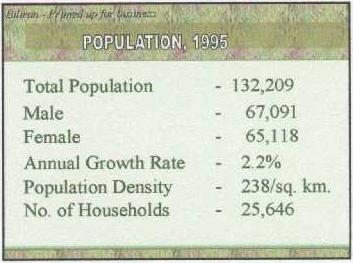    |
BASIC INFORMATION Biliran Province is composed of 8 municipalities with
132 barangays. Its capital town is Naval.
Biliran is located within the typhoon belt of the Philippines.
It has dry and wet seasons, with maximum rainfall during the months
of October to January.
POPULATION The 1995 national census for Biliran Province reported a total population of 132,209 living in 25,646 households. Of the total inhabitants, 67,091 were males and 65,118 were females. There is almost a one-to-one ratio between males and females. Although Biliran has the smallest area and population among the provinces in Region VIII, its population density of 238 persons per square kilometer is the highest. The annual population growth rate is estimated at 2.2%. The literacy rate was 88.52 percent in 1998. HEALTH FACILITIES To serve the health and medical needs of the Biliranons, the province has 4 hospitals, 9 health centers, and 34 barangay (village) health stations.
HEALTH STATUS The 1998 provincial health statistics showed a crude birth rate of 26.97 per 1,000 population, a crude death rate of 5.1 per 1,000 population, an infant mortality rate of 14.07 per 1,000 live births, and a maternal mortality rate of 2.43 per 1,000 live births. These benchmark indicators, all lower than the national rates derived from the 1990 census, indicate a better health status in Biliran compared to other parts of the country. Of note, Biliran's low infant mortality rate is almost comparable to First World standards. The average life expectancy for males is 64 year; for females, 68 years. CHILD MALNUTRITION STATUS (1998) Severe malnutrition - 0.67 percent Number of Doctors - 18 No. of Field Health Personnel - 89 Public Health Dentists - 3 Food and Drug Coordinator - 1 Dietary Nutritionist - 1 Health Educator - 1 Rural Health Inspectors - 5 (provincial), 3 (municipal) Barangay Health Workers - 933 Barangay Nutrition Scholars - 150 Trained hilots (traditional birth attendants) - 180
1. Congenital anomalies 1. Acute respiratory infection 1. Pneumonia |